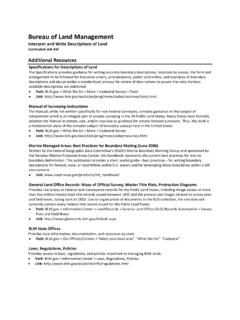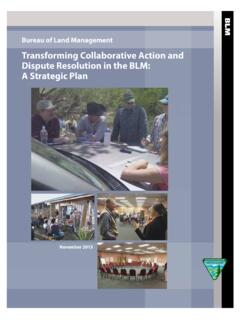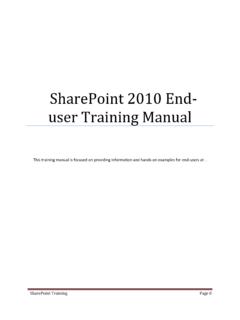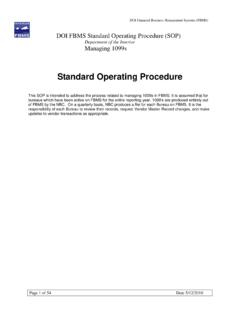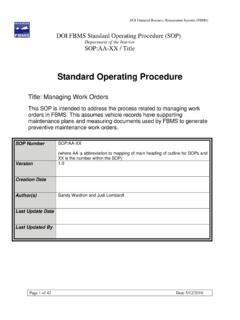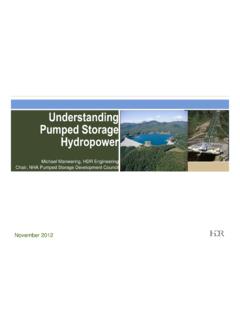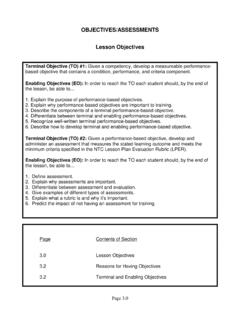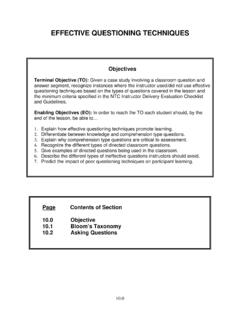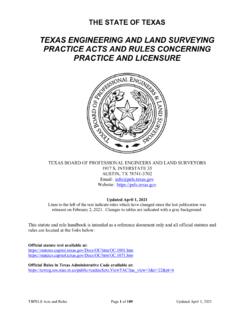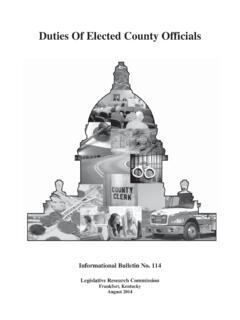Transcription of BLM Module 2: The Public Land Survey System Study Guide
1 BLM Module 2: The Public land Survey System Study Guide 1 of 34 Interpret and Write Descriptions of land : The Public land Survey System ---------------------------------------- ---------------------------------------- ---------------------------------------- --------- This Module provides the foundational concepts and terminology of the Rectangular Survey System : interpreting land location on a map, writing a description of the land using the nomenclature of the Public land Survey System , and emphasizing the importance of punctuation placement. BLM Module 2: The Public land Survey System Study Guide 2 of 34 The objectives of this Module are to help you: explain key land description terminology, apply principles of Rectangular Survey System , interpret subdivisions of sections (aliquot parts), explain excess or deficiency due to convergence, explain why lots were created, describe the preferred writing method elements and proper use, and list the four most commonly used map types and define their use for land descriptions.
2 ---------------------------------------- ---------------------------------------- ---------------------------------------- --------- Lesson 1: Rectangular Survey System BLM Module 2: The Public land Survey System Study Guide 3 of 34 After completing this lesson, you should be able to: explain key land description terminology, apply principles of Rectangular Survey System , interpret subdivisions of sections, and describe the preferred writing method elements and proper use. ---------------------------------------- ---------------------------------------- ---------------------------------------- --------- The Rectangular Survey System was created to provide simplicity to interpreting and describing any piece of land , located on a map or on the ground, and where practicable, its units are in a rectangular grid form.
3 Rectangular Survey information can be found in Chapter II of the Specifications. BLM Module 2: The Public land Survey System Study Guide 4 of 34 The Rectangular Survey System is basically a grid of lines based upon a true meridian and is originated from an initial point. To begin the grid, the surveyor establishes an initial point from which to begin surveying. ---------------------------------------- ---------------------------------------- ---------------------------------------- --------- From the initial point, the surveyor extends a north-south line called a Principal Meridian and a Base Line running east and west parallel to the equator. BLM Module 2: The Public land Survey System Study Guide 5 of 34 Along the north-south line, the surveyor establishes township lines north and south from the initial point.
4 Each line is created at 6 nominal mile intervals. Along the east-west line, the surveyor establishes range lines east and west from the initial point also at 6 nominal mile intervals. Each of these 6 by 6 nominal mile squares is called a township. ---------------------------------------- ---------------------------------------- ---------------------------------------- --------- Correct Answers: A. Township Line, B. Principal Meridian, C. Range Line, D. Initial Point, E. Base Line, and F. Township. BLM Module 2: The Public land Survey System Study Guide 6 of 34 Correct Answer: B. 5 ---------------------------------------- ---------------------------------------- ---------------------------------------- --------- Each township is further subdivided into thirty-six sections of one square nominal mile each.
5 Section numbering begins at number one in the upper right northeast. Sections are numbered right to left and left to right down the rows until reaching the lower right southeast section. This wandering arrangement is based on how farmers plowed their land or as the ox plows. The benefits of this numbering System guarantee that a section is always adjoined by its preceding and succeeding section. A section will never end up next to a confusingly numbered section in an adjoining township. BLM Module 2: The Public land Survey System Study Guide 7 of 34 When describing portions of regular sections, aliquot parts, or exact divisions of the whole are used. In other words, quarters are described in their relative position within the section.
6 Any parcel listed as northeast, northwest, southwest, or southeast is a quarter part. A combination of aliquot parts, for example two equal quarters, can be described as half of a section. Aparcel reading north, south, east, or west is a half part. Later you will learn the use of half of a half descriptions that must be avoided in writing descriptions of land . ---------------------------------------- ---------------------------------------- ---------------------------------------- --------- Along the township and range lines, corner monuments are set every nominal mile at all section corners. Monuments, called quarter corners, are set at mid-point between each mile marker. These monuments are called quarter corners because when connected, they form the legal boundaries that divide each section into quarters.
7 Quarter parts can be further subdivided into quarters and each quarter equal to 40 acres. The 40 acre quarter-quarter is considered by BLM as the standard land unit for management purposes. However, these quarters can then be further subdivided into quarters and each quarter equals to 10 acres. These 10 acre quarters can then be further subdivided into quarters and each of these quarters is equal to 2 acres. BLM Module 2: The Public land Survey System Study Guide 8 of 34 Lesson 2: Excess or Deficiency by Convergence ---------------------------------------- ---------------------------------------- ---------------------------------------- --------- After completing this lesson, you should be able to: Explain the principle of creating lots within the rectangular Survey System due to excess or deficiency in land areas with a township or section.
8 BLM Module 2: The Public land Survey System Study Guide 9 of 34 For various reasons, not all sections contain 640 acres, which is contrary to the plan of the rectangular System as shown here. The sections along the north tier and the west range of a regular township are often irregular sections and contain lots. These non-aliquot parts are designated by section and given a lot number. Though lots may contain more or less than 40 acres, they are considered a subdivision unit of a section. ---------------------------------------- ---------------------------------------- ---------------------------------------- --------- As a surveyor works north from the initial point, range lines do not continue in a straight line because of the curvature of the Earth s surface.
9 If not corrected, the township on the baseline would contain more area than one further north. BLM Module 2: The Public land Survey System Study Guide 10 of 34 To correct for this convergence, surveyors establish Guide meridians and standard parallels every 24 miles in each direction from the initial point. ---------------------------------------- ---------------------------------------- ---------------------------------------- --------- To compensate for loss in acreage to the convergence a land unit called lots was created. Lotting usually occurs in the north and west of each township. This is due to excess and deficiency in area created by convergence or because the township is abutting a previously surveyed township.
10 Lotting also occurs when special surveys such as mineral surveys, and the meandering of rivers and lakes because the reduced land area around them cannot be described in aliquot parts. Lots are numbered similar to the 36 sections of a township. Lots are normally numbered starting in the northeast corner of the section in a counterclockwise direction but because of irregularities of land features lot numbering systems do vary. Following are visual examples of how a lotting scheme is portrayed on plats. Additional details can be found in Chapter 3, Subdivision of Sections in the 2009 Manual of Survey Instructions. BLM Module 2: The Public land Survey System Study Guide 11 of 34 Displayed here is an example of typical lotting.

